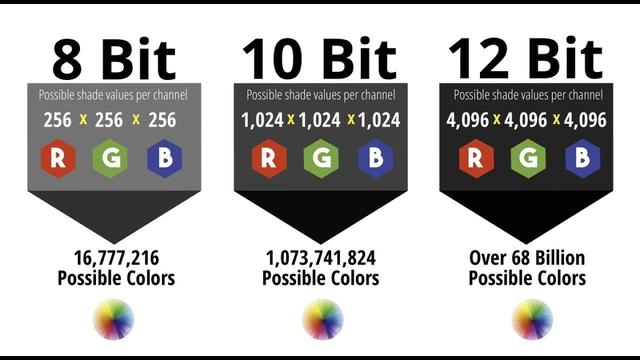constituent units
Color depth is described by "n-bit color" (n-bit colour). If the color depth is n bits, i.e. there are 2 ^ n selected colors, the storage number of bits per pixel used is n. Common are:
(monochrome): two-color black and white.
2 Bit: 4 colors, for CGA.
4 Bit: 16 colors, for CGA, EGA and VGA.
8-bit gray scale: are among black, gray, white, 256 levels.

15, or 16-bit color (High Color): three primary colors used in computer red, green and blue. In 15-bit color, each primary color has 2 ^ 5 = 32 levels, a total of 32,768 kinds of colors; in 16-bit color, the green has 2 ^ 6 = 64, a total of 65,536 colors.
24-bit color (True Color): each primary color has 256 levels and combinations thereof, will have 256 * 256 * 256 colors.
32-bit color: 24 color except the color, is extra 8-bit data storage pattern superimposed layers (alpha channel).
Another high dynamic range images (High Dynamic Range Image), which is generally more than 256 images used to store the gradation image, generally speaking assigned to each pixel 32 + 32 + 32 bit to store color information, which means that for each primary color uses a 32bit floating-point number to store.
applications
digital camera
color-digit Also known as color depth, color depth indicator digital camera camera correctly reflects the tone record number, the higher the value of the median color, the more likely to restore a more realistic light and shadow details are. Color bit binary digit (bit) units, with the number indicates how many bits of the number of colors. Almost all colors digit digital cameras have reached 24 (that is, the power of 24 colors can express 2), can generate true color images. In short high color digits, you can get a greater dynamic color range. In other words, to be able to distinguish colors more delicate.
The most common digital camera is 24, 30 of the camera rarely seen. Specifically, each primary color is generally employed in the camera 8 or 10 bits, the three primary colors red, green, and blue primaries median total color by 3 bits, i.e. 8 × 3 = 24 bits or 10 × 3 = 30. Camera median color reflects the camera can correctly represent the number of colors to 24, for example, three primary colors (red, green, blue) each accounted for 8-bit binary number, that can be divided into red 8th power = 256 different levels, green and blue as well. Then the combination thereof is 256 × 256 × 256 = 16777216, i.e., about 1600 million colors, and 30 may represent one billion kinds. The higher the value of the color depth, the more realistically restore the color.
Scanner
median color (color depth), also known as color depth. It is an index representing the scanner can discriminate the color range. Generally, the more bits color scanner, the richer the more truly reflects the original color image, color scanner, reflected, an image of the sweeping effect is more realistic, the data amount will of course also be formed increases, resulting image file size also increased. For some environments, scanners, color-digit index, even more important than resolution. DETAILED color index number of bits is "bit" ( 'bit, i.e., how much power of 2) will be described, 24-bit color scanner showed 16.7 million colors can be distinguished and 30-bit color is 6.85 billion colors, while 36 true color is a 167 billion kinds of colors. While most graphics cards only support 24-bit color, but because of CCD photosensitive curve of the human eye, in order to ensure accurate color reproduction, it needs to be corrected, which requires median color scanner to reach at least 36 in order to obtain more good color reproduction. Thus, it should be possible to purchase more than 36 bits of color scanner.
is the number of bits of digital color scanner bits per pixel sampling point to provide different channels of the superposition of values.
It generally uses a sum value of each RGB color channel expressed. Quantized values common 24bit, 30bit, 36bit color scanner, each of eight channels, respectively, 10, 12, 256,1024,4096 hierarchical information showing the times each of the channel. The median color scanner refers to the number of bits per color a color pixel dots on scanned in, which is one of the biggest difference on the scanner and the printer indicator. In general, the median color scanner depends on the accuracy of the analog to digital converter inside the scanner. When increasing the number of bits of color accuracy, color scanning device can capture details will also increase. However, if one wants simply by adding the analog to digital converter accuracy, improving the accuracy of the color scanner, the degree of improvement of the quality of the scanned image is relatively limited. Because the factors affecting the color accuracy of the scanner, in addition to a high precision analog to digital conversion, but also requires a perfect optical design system. The quality of the lens, and the vibration mass CCD scanning optics, scanner noise will increase, thus affecting the quality of the scan.
